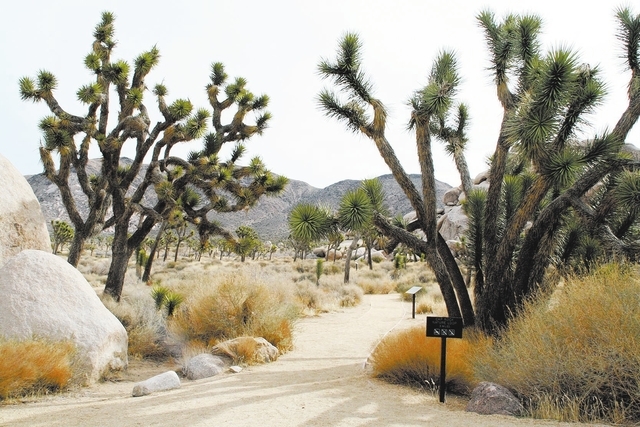
Joshua Tree National Park in Southern California may be named for a tree you can see closer to home, but it also offers some other attractions worth the 200 mile drive.
Sprawling over 794,000 acres, it boasts five palm oases, which are otherwise rare in North America, interesting historical sites and a location easily incorporated into visits to Palm Springs or San Diego. It is internationally famous for rock-climbing opportunities, with 8,000 climbing routes on more than 400 granite formations.
A good place to start an experience here is at the Oasis Visitor Center, just outside the town of Twentynine Palms at an elevation of 1,960 feet. Besides natural subjects, the fine exhibits cover the park’s human history, which dates back as far as 7,500 years. Those who frequented the park in those days are known now as “the Pinto people,” members of one of the earliest cultures identified in our region.
Directly behind the visitor center is the Oasis of Mara, one of the park’s five oases of fan palms (Washingtonia filifera). There are only 158 such groves in North America. These palms need a constant supply of water and here they get it from natural underground sources resulting from a major earthquake fault and fractures in this area. Washingtonia fan palms live a long time, averaging 150 years, and are the tallest palms native to this continent, sometimes reaching 75 feet. To view these unusual trees there is a one-half mile loop trail, paved and fully accessible even to those visitors requiring mobility assistance.
After leaving the visitor center a good way to see the park is taking a drive out to Key’s View Lookout, about 24 miles away. There are plenty of places to stop along the way and you will be traveling through many vegetation zones. One must-see place is the Cap Rock Nature Trail. This easy 0.4 mile loop trail takes you through distinct granite formations and you’ll get to easily see some of the park’s other native plants such as peach thorn, desert almond, galleta grass and Mojave yucca.
Key’s View Lookout is located at a higher elevation, about 5,180 feet, so you will find pinyon pines and juniper there. The short trail leads to the viewpoint itself, where you can get far-reaching views of the Palm Desert and the Salton Sea to the southeast.
The Joshua tree park supports quite a wide assortment of birds including Scott’s oriole, western screech owl, loggerhead shrike, ladderback woodpecker, American kestrel and red-tailed hawk. There are 52 species of mammals that make the park their home, including a couple of hundred desert bighorn sheep.
Winter is my favorite time to visit the park. This time of year you will find plenty of solitude and for February, daily average temperatures at the lower elevations are in the mid-60s.
Many make day visits to Joshua Tree on the way to Palm Springs, about 60 miles from the visitor center, or to San Diego, about 170 miles. But there are nine campgrounds in the park, primarily first-come, first served with fees from $10 to $15 per site. From October to May only, you can reserve a site at Black Rock and Indian Cove campgrounds through www.recreation.gov.
For more information about the park, call 760-367-5500 or visit www.nps.gov/jotr.
Many of Deborah Wall’s columns were recently compiled with new information and photos in “Base Camp Las Vegas” and published by Stephens Press. She is the author of “Great Hikes, a Cerca Country Guide.” Wall can be reached at Deborabus@aol.com.